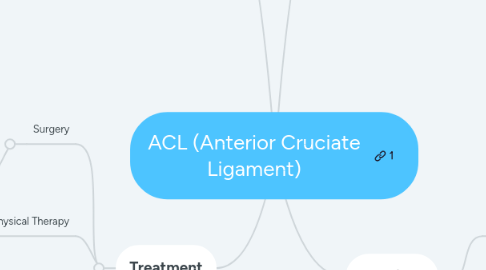
1. What is it?
1.1. Definition
1.1.1. 1 of the 4 ligaments that support and stabilize the shin bone from moving too far forward by limiting the rotational movement of the knee
1.1.2. a simple quick change in direction, an awkward land from a jump, suddenly stopping or a force from a collision to tear the ligament
1.2. ACL VISUAL
2. Treatment
2.1. Surgery
2.1.1. ACL reconstruction involves replacing your torn ligament with a graft. In ACL, a graft is usually a piece of your own knee tendon or tissue obtained from somewhere else in the body which is put in place of the injured ACL.
2.1.1.1. 6-8 month recovery time with physical therapy.
2.2. Physical Therapy
2.2.1. Includes basic programs to help you regain strength and stability, injury-specific programs, or sport-specific programs.
2.2.1.1. Before surgery prehabilitation- goal is to strengthen the muscle groups in the affected leg to increase the chances of a better functional outcome after ACL reconstruction
2.3. Non-Surgical Treatment
2.3.1. You actually don't need the use of your ACL as long as you aren't participating in activity heavily involving pivoting, jumping, cutting
2.3.1.1. A custom sports brace may be fitted for patients who want to return to athletic activity
2.3.1.1.1. Most athletes still end up getting the reconstruction because physical activity feels different and is more limited after ACL tearing
2.3.1.2. People who aren't required to be on their feet/ constantly moving can bypass the need for an ACL- for example, people with office jobs
2.3.1.3. You can still perform basic movements such as running, as long as it's in a straight line
3. Risks
3.1. Tearing
3.2. Statistics
3.2.1. Women are 2-10 time more likely to tear their ACL's than their male counterparts
3.2.1.1. Mainly due to the anatomical differences between men and women
3.2.1.2. Women are born with weaker hips and a wider pelvis which makes their thigh bones angle down sharper than men’s so more pressure is applied inside of the knee
3.2.1.3. The Intercondylar Notch (where the ACL passes through) tends to be smaller in women, but so is the ACL itself, making it more prone to injury
3.2.2. 70% of ACL injuries happen from non-contact circumstances
3.2.3. One of the most common knee injuries no matter what age or fitness level
3.2.3.1. Women's soccer is number 1 sport for the most ACL injuries, followed by basketball and football
3.2.4. Every year between 20,000 to 80,000 female high school athletes sustain an ACL injury in the U.S.
3.2.4.1. 91% are season-ending injuries
4. Solutions
4.1. Prevention
4.1.1. Implementing prevention programs that have proven to reduce the incidence rate of ACL injuries in female athletes.
4.1.1.1. For example, neuromuscular training programs (NMT), educational interventions, proper coaching as well as specific exercises/ stretches that strengthen the ACL to minimize the chance of injury
4.2. Awareness
4.2.1. Too many young female athletes, don’t even know how at risk they are until it’s too late. By spreading awareness to female athletes of their potential risks and informing them of preventive steps they can take, we can help reduce this incidence rate of this preventable injury.
4.2.1.1. Coaches who train female athletes also need to be made more aware of the greater risk women have of incurring an ACL injury followed by implementing prevention programs.
